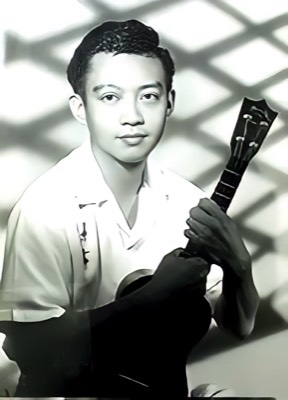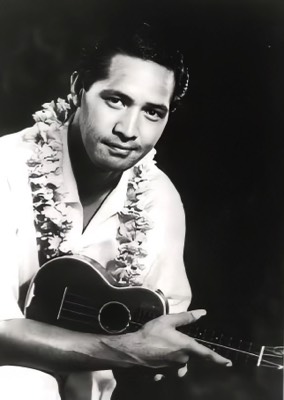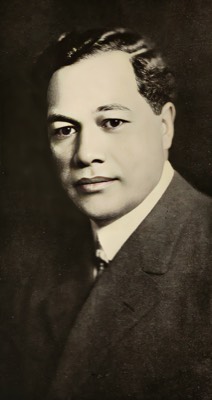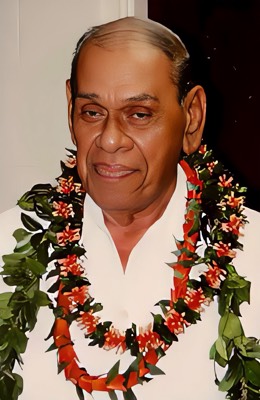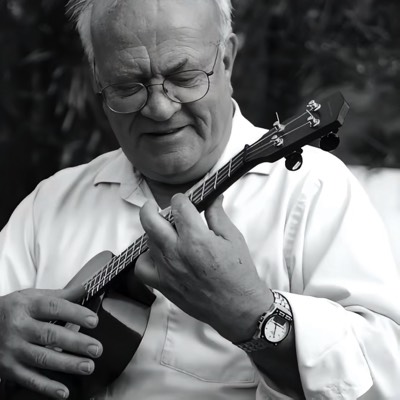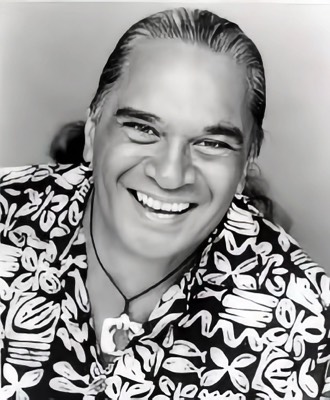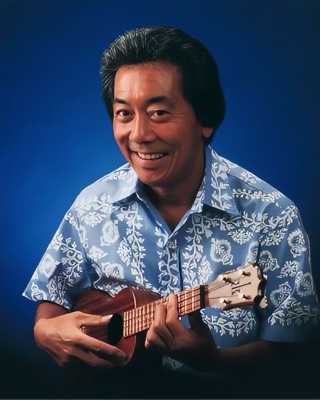`Ukulele virtuoso, musician, singer, actor. Born in Honolulu on October 30, 1920, 2nd of 4 children to mother Amy Pakiko of Napo`opo`o, S. Kona, and father, Jesse Andre of Kailua, Kona. In 1926, at a very young age, Jesse's father passed away. Later, Amy Pakiko remarried Solomon Kalima and had a daughter. Jesse grew up on Green Block in Pālama and attended Kai`ulani School, Central Intermediate, and Farrington High School.
Jesse's mother, Amy, a teacher and democratic district president, also a singer and musician, performed with Lena Machado. At the age of 9, Jesse performed with his mother doing the hula on a flatbed truck for territorial political rallies. He learned to play the `ukulele from his mother at the age of six.
The family played in the American Legion Band. While at Farrington High School, Jesse played on the football team, also played the baritone saxophone in the school band where he learned to play marches like, "Stars & Stripes Forever", "Under the Double Eagle", and "Hilo March", and transferred the marches on to `ukulele. At age 15, he won 1st place in the Listerine Amateur Hour on KGMB, playing "Stars & Stripes Forever" and taught his brother Albert to accompany him on the stand up bass. He performed at Farrington's first Ho`olaule`a. His teachers were his biggest fans. In school, Jesse carried his `ukulele and someone else carried his books. He left school in his senior year to go to work.
Jesse moved from “Green Block” in Kalihi-Palama to Kapāhulu, where his mother died at the age of 39. Jesse traveled the islands playing in a dance orchestra with Henry Mucha on piano and he on saxophone. He taught his brothers, Albert and Honey to play musical instruments. Albert became one of the best upright bass players and Honey, a fine musician on guitar with an outstanding falsetto voice. Jesse’s sisters, Amy and Koleka also would join the group from time to time. About 1938, he formed a group with his brothers, and cousins, Junior Kalima, Julian Gaspar on steel guitar and Henry Mucha on piano. Their first job together was at a restaurant and their payment was food. You can imagine that the owner’s of that restaurant would have been richer if they paid the group in cash!
Their first big show was at the Princess Theater Pot Luck Show, with 3 hula dancers, (who also danced with his mom) Leilani Awo Alameida, Ida Wong, Momilani Victor Reeves (Keanu Reeves grandma), a female knife dancer Siliwa Kaleikini and a comic hula by Mona Kalima of the "Hilo Kalima’s". Curtis Kekoa, now a retired Colonel of the air force, was occasionally featured as a baritone vocalist. The success of the show landed a long contract at the Seaside Gardens.
Jesse worked during the day at the Shell Oil Company. Then in 1940, he married the girl next door, Dorothy Louise Routh Halouska, the boss’s daughter. Even as Pearl Harbor was invaded, he had to report to work at the oil company.
In 1942, Jesse and his wife moved to 256 Wai Nani Way in Waikīkī, where they later raised six children, Margo, Jesse Jr., Marsha, Dana, Andrea, & Kaliko. The Kalima Brothers had a strong following. During this time of war, Henry Mucha, his piano player, was drafted into the army. Jesse’s search for a young, talented musician ended when he heard this handsome young 13 year old, Richard Kauhi playing the organ at the Kapāhulu Theater. From then on, Richard was part of the family playing and practicing on Jesse's tiny stand up piano. Jesse was very particular of the sound he wanted from the piano and Richard learned very quickly.
The Kalima Brothers & The 1000 Pounds of Melody, a name they gave themselves because of their size and combined weight, made their first recording on the Bell Records label. They recorded many songs and also accompanied the group Kani Leo's.
Jesse loved the beach, he had a taxi stand across from Kūhiō Beach and a lot of kolohe things went on, like streaking across Kalākaua Ave. and skinny-dipping. Beach boys would come to the house and pick up the piano and carried it to Kūhiō Beach under the banyan tree, where Jesse and the gang would have jam sessions.
In 1948, Kalima Brothers played at Pago Pago, where he met Lucky Luck just out of the Marines. Jesse helped Lucky Luck set up a bottle club on Kalākaua Ave. and became close friends ever since. The Kalima Brothers performed at many USO shows, featuring Lucky Luck and Eddie Sherman, along with comedian, Gabby Gomes.
Jesse, Albert and Honey rehearsed with Johnny Costello, Jimmy Kaku, and Twinkle along with Sonny Kamaka in Jesse’s garage. They later played at the Koko Head Tavern as the "Kalima Jrs.". Later, Richard Kauhi formed his own group with these boys.
Jesse's garage also served as a place for old fashion, 3-day luaus, weddings, baby luaus, and a place where many would stop by. Just to mention a few - Eddie & Betty Cole (Nat King Cole's brother) on the piano out in the lawn. Also, James Darren, Richard Boone and a whole movie cast, Gabby Pahinui, Andy Cummings, Kahauanu Lake, Don Ho, Kui Lee, and many great island entertainers. It was also a place for teenagers to gather. A teen club called the Go-Getters Club with members likes Marlene Sai, Jesse's children, and other teenagers from around the neighborhood. His home was always open for the beach boys or anyone who needed a place to stay or sleep.
In 1950, Jesse opened a music store on Kalākaua Avenue selling `ukuleles with his own label. Just before that, he had a hamburger stand, also in Waikiki, on the corner of Kalākaua and Kapahulu.
During the 50's, Jesse & The Kalima Brothers traveled to Chicago and played at Club Waikiki. About this time, Jesse’s cousin, Julian Gaspar, passed away. Benny Kaneaikala joined the group to replace Julian. They later traveled to New York and boarded the S.S. Leilani on its maiden voyage to the Caribbean and through Panama Canal. The Stardust Hotel in Las Vegas with Mahi Beamer was a highlight of his travels.
Junior also was drafted and later he and Henry Mucha called California home. Honey pursued other interests. Honey recorded with the Royal Hawaiian Serenaders and performed at the Tahitian Hut in San Francisco.
Along with brother Albert, Jesse formed a new group with Sonny Waia`u on piano and Stanford Shutte on percussions. They recorded their first LP album, "Holiday in Hawaii" Luau time, produced by Sounds of Hawaii, Inc. on Lehua record label. "Lepe ula `ula" and "Po Me Ke Au" was just a couple of the outstanding songs on this album.
Sounds of Hawaii was so pleased with the first album, they called Jesse once again to record an instrumental album with just the ukulele. And so, he recorded his second LP, "Jess Uke", with songs like "Nani Ko`olau", "Haunani Mine", and "Hilo March".
Jesse recorded a single 45 with the song, "Nanakuli Ea" which became quite popular. "Richard Boone's Slack Key" was on the flip side, which he composed and dedicated to the actor. It was used in the documentary, "Mark Waters Story".
Jesse traveled to California to do the musical score for the movie "Kona Coast" starring Richard Boone and also, "Mark Waters Story" a documentary for an anti-smoking campaign.
Richard Boone and Jesse went to many parts of the island where Jesse would teach the `ukulele and Richard Boone would teach acting to teenagers as an outreach program. Kamaka `Ukulele donated instruments for this project.
Early 70's, brother Albert died. It was very hard for Jesse to replace him and then he met Cyrus Green, a gentle man with a beautiful voice.
Jesse opened up his own nightspot, called Jesse’s that used to be Kapahulu Tavern. There they played music and featured vocalists like Leina'ala Haile.
One of the proudest moments of Jesse's life is when he got to play with his sons, Jesse Jr. on bass, and Dana on percussions. They recorded their 3rd LP, "Jesse Kalima and Sons" with Sonny Waia`u, with songs like, "Kilakila O Moanalua", "Hilo Hula", "Mai Puni". He also featured his sister Dorothy "Koleka" singing "Punalu'u", also a very special song to Jesse, "Ka I'iwi Polena", which he took from a very old recording of his mother.
Also in the 70's, Little Joe Kekauoha and sister Koleka along with son, Jesse Jr., teamed up with Jesse and continued to play the circuits.
There was an occasion that touched Jesse very much. He volunteered to play at nursing homes. While playing at the Beverly Manor, he was told that this Hawaiian man never talked since he's been there at the nursing home. Jesse went over and sang a Hawaiian song to him, and to everyone's surprise he began to sing along with Jesse. Beverly Manor later honored him by having a “Jesse Kalima Day.”
Just before his passing, Jesse along with Little Joe, Jesse Jr. and his daughter, Andrea a hula dancer, gave his last performance at The Royal Hawaiian Poolside. After that performance, they went to see Don Ho at Polynesian Palace. They had a good time especially when Don called upon Jesse and Little Joe to sing a few songs. That was his last performance. After returning home and sharing his night experiences with his wife, Jesse passed away hours later in his wife's arms at the age of 59.
Jesse Kalima was a strong family man, with a very close family. He left behind a legacy of love and music. His children and grandchildren continue his legacy until this day.
This is from an editorial by the Star-Bulletin:
Jesse Kalima gave tons of music, laughter and tears to Hawai'i before his death.
"I cry music," he said in a 1972 Star-Bulletin interview.
"If I sing a song that touches me, I cry. You cannot
be a mechanical musician. You must love music within
your heart. People can tell when you sing from your heart."
Jesse's heart is still now, but his music lives in the memories of many.
• Jesse Kalima and Brothers were the first Hawaiian group to perform on live television on KGMB.
• He was the first to amplify a ukulele. He cut a rubber tube to hold the mike in place.
• The first Hawaiian band hired to perform on a steamship sailing out of Hawaii.
• Morrow’s Nut House named a candy after him. A recipe he came up with.
• Lifetime member of the American Federation of Musicians
• Member of the Elks Club
• Inducted in the Ukulele Hall of Fame in New Jersey in 2002
• 2005 Na Hoku Hanohano Lifetime Achievement Award
TV appearances:
Kinipopo Show (Live)
Lucky's Lanai
Don Robb's Show (frequent guest)
Leonard's Bakery commercial
Royco Pluming commercial - Played a character "Noa Liki" and came up with the word "pipeline" (pronounced like a Hawaiian word)
Performances:
Seaside Gardens
Biltmore Hotel
Dan’s Den
Lau Yee Chai
Elbow Room
Kalia Garden
Queen’s Surf
Rickshaw
Grand Hotel
Pago Pago
Stardust - Las Vegas
Surfrider Hotel
Florentine Gardens
Bowling Alleys
Castanola’s
Woodland
Yoko’s
Ginza Cafe
Haiku Gardens
Dot’s Drive Inn
Waikiki Harry’s
Kewalo Inn
Club Waikiki - Chicago
The Dragon’s Den
Park Shores Hotel
Zebra Room
Waikiki Holiday Inn - opening
Fort Shafter
Hawaiian Regent Hotel - opening
Waimea Ranch Hotel
Hofbrau
Trader Vic’s
S.S. Leilani Cruise
Top of the Isle
Niu Malu Room
Many Parties
Many Special Guest Appearances
Note: This profile and photo was given to Herb by The Kalima 'Ohana for this website.
Special Mahalo to Kaliko!


